In the Barri Gràcia, we bite into La Bomba tapas, which pay tribute to historic Barcelona anarchists who fought in the Spanish Civil War. They go down easy with today’s Catalán identity.
“Watch out, the brava sauce is spicy,” warns Renee. In Barcelona’s Gràcia neighborhood, a labyrinth of tight historic streets, we are biting into La Bomba tapas.
Note: This post contains affiliate links and/or references to our advertisers. We may receive compensation when you click on or make a purchase using these links.
Carlos, the owner of L’Anxoveta, hovers anxiously, water at the ready. They couldn’t have known my husband. It’s the sort of statement he takes as a challenge, while simultaneously acting as my taster.
“You’re safe,” I hear, so I take a bite, too. And just like that, we both become obsessed.
La Bomba tapas. Our first day in Barcelona, and we get a twist on a traditional tapa with a fascinating history, served in a trendy modern space on a tiny ancient street. This moment will encompass every impression we get from Barcelona.
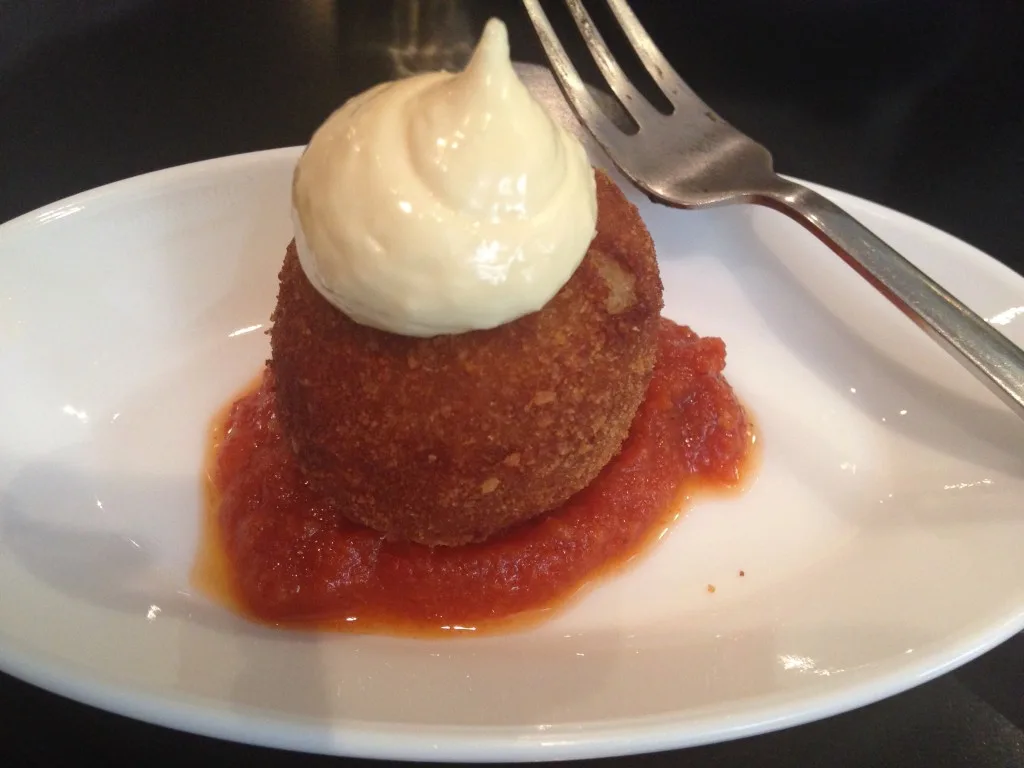
La Bomba tapas. They’re crispy croquettes filled with a mix of potato and meat, centered in a pool of red picante brava, topped with an aioli fuse.
Renee tells us L’Anxoveta was born out of a dream. When economic hardship during a recent recession caused Carlos to lose his job, he opened a restaurant. He thought he’d be better at being his own boss. Renee thinks he serves the best La Bomba tapas in town, and she has brought us here as part of a food tour of the Gràcia neighborhood.
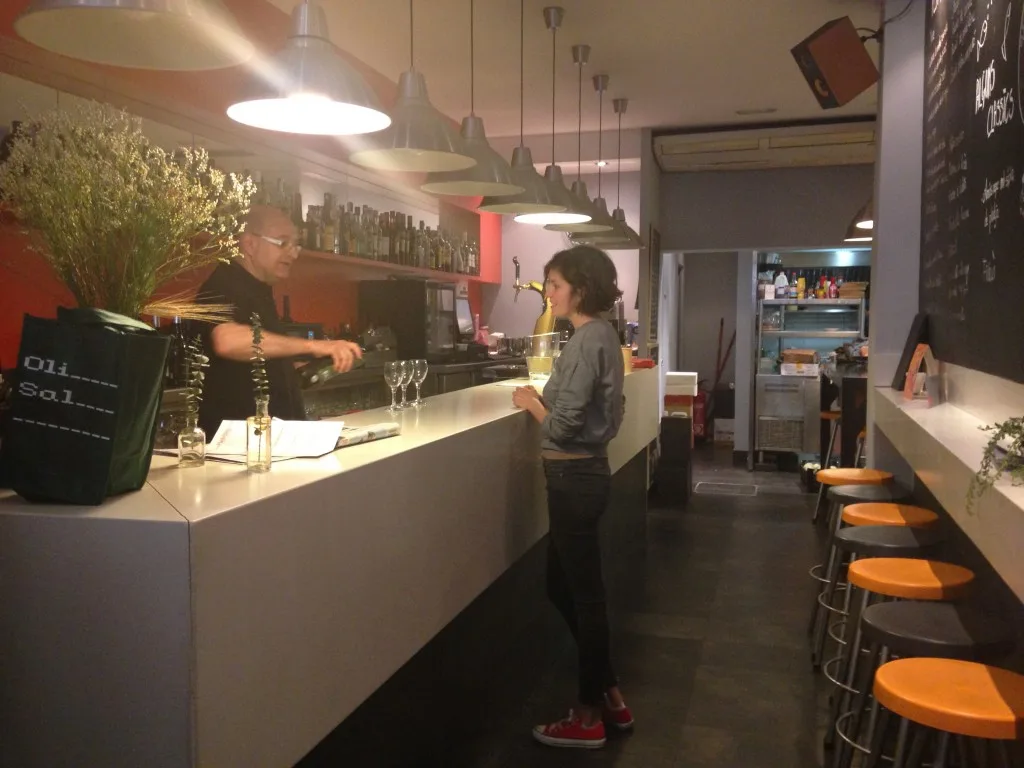
Renee goes on to fill our day with great culinary finds scattered across Gràcia, a village founded in the 17th century by Carmelites. It was swallowed up into Barcelona when the Eixample plan merged Old Town districts dating from medieval times with neighboring villages. The result: a bustling new city that straddled the 19th and 20th centuries. But at the end of our day with Renee, on impossibly full stomachs, we’re still obsessed. It’s La Bomba tapas we think about. We want to eat them again, and we want to know more about how they came to be.
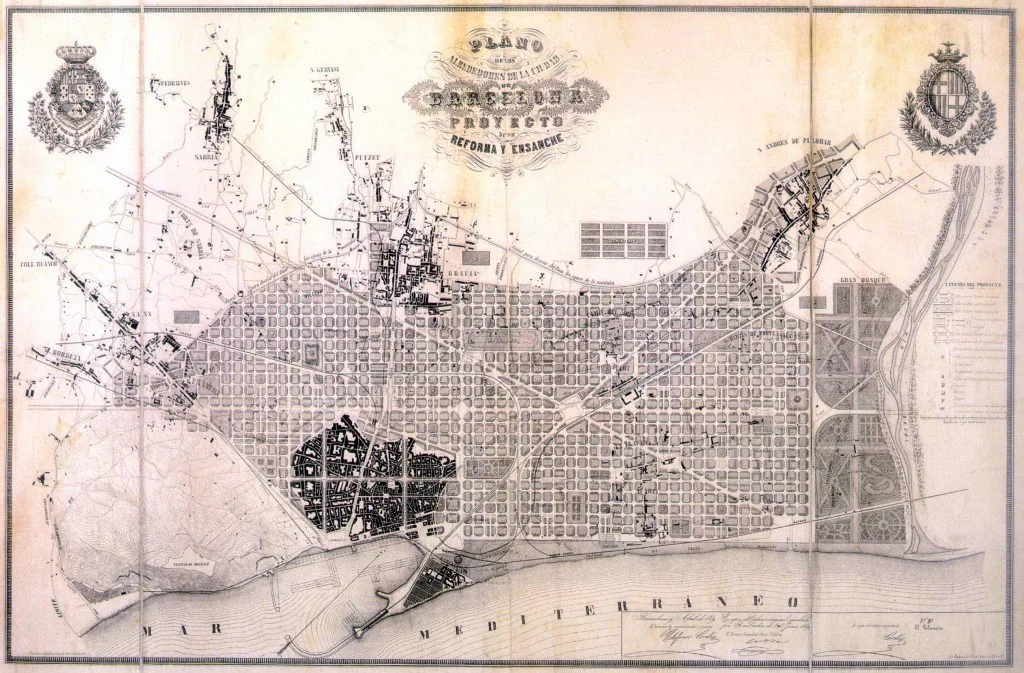
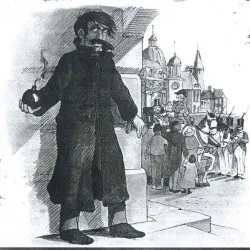
As the Eixample modernized Barcelona, alternative ideologies were blooming in Europe. With the wealth and population shifts that had risen out of the Industrial Revolution during the 19th century, came economic disparity. In Barcelona, violence was frequent as anarchists, police, gangsters and hired guns, as well as Republicans and bourgeoisie, clashed for control. Bombings and assassinations began in the 1870’s and continued through the 1920’s and 1930’s, as a series of workers’ movements rose and fell.
The anarchist’s weapon of choice in those days was an iron ball packed with explosives, ignited by a lit fuse.
In a most excellent video series, Anarchism in Barcelona: The Spanish Civil War (Part 1 of 2), the Vagabrothers interview Nick Floyd, guide for an anarchism themed tour of Barcelona, who provides more historical clarity:
“Until the 20th century, there’s nothing unique about Spain [in terms of anarchism]. Anarchism has a very long history in France, Italy, Europe and elsewhere. But the difference is, at some point in the early 20th century, it gets supplanted by socialism and communism in the rest of Europe. In Spain, instead of that, it grows.”

Forgotten Places: Barcelona and the Spanish Civil War is Nick Floyd’s monumentally researched and passionately documented combination of big picture narrative and detailed, localized events. This background information is even more timely now with respect to the recent Catalan independence referendum and the suppressive tactics undertaken by Madrid to quash hopes of secession.
In La Barceloneta, a since-gentrified, but then lower class, waterfront neighborhood, anarchists traded contraband and revolutionary boasts in bars and taverns. Both Sills and Renee repeat the story: At La Cova Fumada (the Smoky Cave), barkeep Maria Pla shaped round potato and meat croquettes. Then she got the cheeky idea to plate them with aioli and spicy brava sauce to resemble bombs with fuses lit in a pool of blood. La Bomba tapas.
Renee says, “most Barcelona foodies know that during this time of instability, La Bomba tapas were intended to make light of the chaos.” This stands to reason: it’s hard to imagine Barcelona surviving over the last 100 years without a mitigating perspective. We’ve already noted the Catalán penchant for lingering in each present moment. This kind of happiness roots in despair, even as it flourishes in the sun.
Nick Floyd goes on to explain,
“Historically, Barcelona has always been the city most associated with anarchism because it’s where the most remarkable experiment with anarchism took place, which was in the summer of 1936.”
On July 19 that summer, shots were fired while the city was filled with more than 6,000 athletes from 22 countries. Countless spectators had come for the Olympiad Popular. This event had been organized in the face of the controversial Berlin Games, in which American Jesse Owen would famously compete and win, much to Hitler’s disgust. In Barcelona, all these visiting foreigners would instead see a revolution and the start of a Civil War.

Franco’s coup against the Republic was infamously bankrolled by the Nazis. Ensuing attacks by fascist anti-republican forces had Barcelona’s anarchist/unionist workers defending the city with weapons they had to illegally seize. After beating off Franco, they then took over the factories where they had worked.
Over the next few months, Barcelona’s anarchists went on to collectivize thousands of other symbolic entities – 4-star hotels, certain churches, and administrative buildings – in a proletarian coup. Public services – transportation, shipping, power and telephone companies – and communications enterprises – theaters, newspapers and printing companies – were run by worker committees. And run well, by the ordinary people who had always been told they could not. All work was made equal.
“Everywhere change was apparent. The whole character of Barcelona changed. Posh restaurants no longer existed. Collective eating houses took their place. A spirit of comradeship was in the air.” – Eddie Conlon, The Spanish Civil War: Anarchism in Action (1984)
Click here if you can’t see the fascinating video interviews with actual participants below:
Things took a darker turn as leftist ideologies splintered. Over 7,000 religious clergy were killed, as it was thought they represented the old regime. Religious relics and tombs were desecrated. In May, 1937, pro-Stalinist forces killed hundreds of anarchists and their allies over a 3-day period in an attempt to wrest control of the telephone system. And economic challenges, caused by foreign embargoes and the seizure of the gold reserve by the Fascist government, hamstrung Catalunya’s immense productivity by limiting access to raw materials.
In 1939, Barcelona fell to fascism, along with the rest of Spain, under Franco.

Homage to Catalonia – Author George Orwell (Animal Farm and 1984) chronicles his personal experiences in the militia during the Spanish Civil War, after traveling to Spain to report on conditions as a journalist. Seriously wounded, Orwell returned to Britain to consider how reality confronted idealism and wrote this tribute to his colleagues.
Nowadays, Barcelona’s Apple Store occupies the building which once was the Communist Party headquarters. Instead of Lenin and Stalin, iPads and MacBooks are icons of the people. In Anarchism in Barcelona: The Bank and the Bike Shop (Part 2 of 2), the Vagabrothers go on to examine modern-day anarchists who exist on the edges of Barcelona society. These groups, the main of which is Okupa, use methods like squatting, vandalism, education and workshops in self-sufficiency, and takeover protests.

But the most remarkable aspect may be their volunteer community services such as clothing and bike exchanges which win hearts and minds against capitalism and government control. There is even a post-capitalistic community set up in an abandoned industrial center on the outskirts of town. Barcelona anarchists acknowledge their activities are necessarily temporary because of illegalities, but the ideological value of group strength within a self-sufficient framework is appealing to many.
We go back to Gràcia armed with more information and recommendations in an email from Renee. First stop is a return to L’Anxoveta. Carlos deserves simultaneous blame and compensation for the initial introduction. We find him happily busy, serving diners with a broad smile. He is truly a better boss of himself than anyone else might be. After more than a week in Catalunya, this is a common story that we can relate to as entrepreneurs.
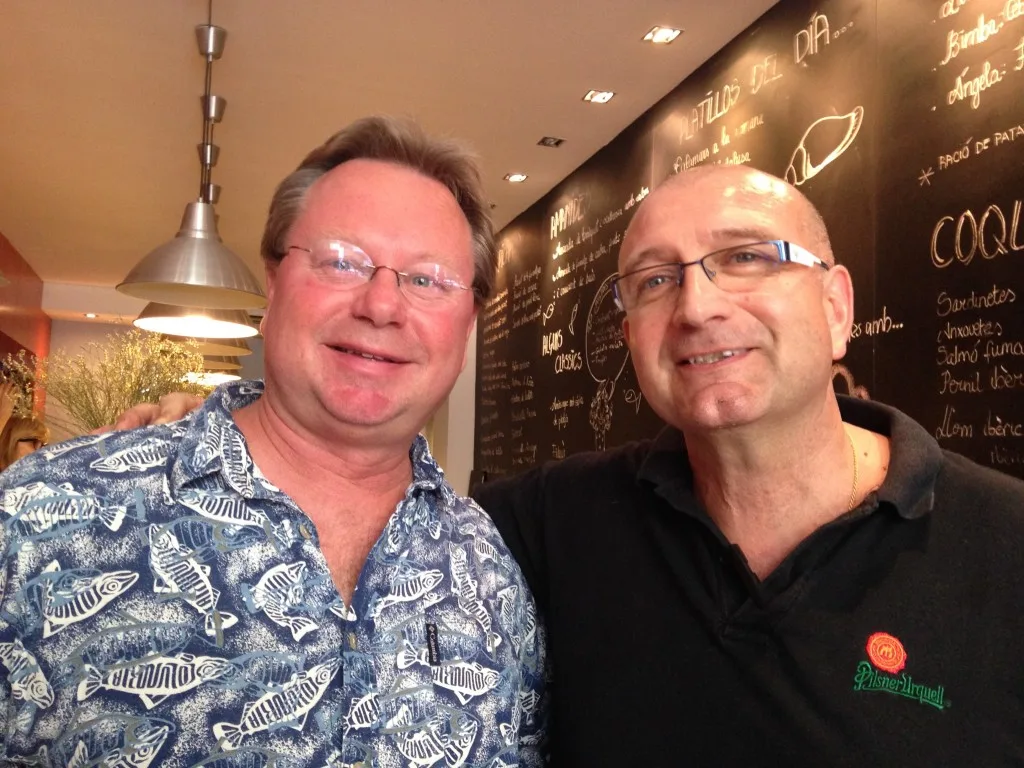
Ordering up “La Bomba, dos,” Pete’s getting proud of his new Spanish. Uno for me. The flavors blend: tartly perfect aioli, and a sweet picante bite in the brava sauce. Crisp shell and smooth inner texture. We do it again.
Not too far away is Cafè Pagès. Renee had taken us to the owner’s father’s bar, Casa Pagès, around the corner for sandwiches of grilled botifarra sausage. Now in her email she lets it slip that the son’s Cafè makes good La Bomba tapas. We make a beeline.
The atmosphere in the Cafè is retro, and it’s easy to imagine it being here just as it is during the war. Confidently, we order Las Bombas, three for Pete and two for me. The server looks horrified. “No!” she exclaims. “La Bomba is big! Try just one and see!” Chastened, we comply.
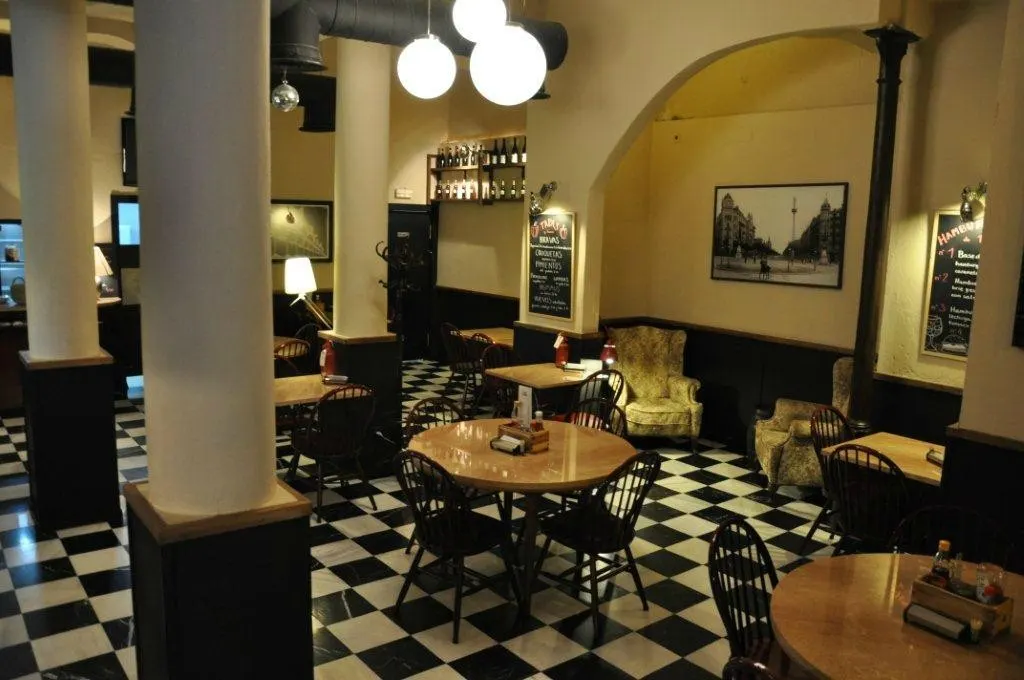
Cafè Pagès’ La Bomba tapas are twice the size of the ones at L’Anxoveta, and taste different, too. There is no brava sauce, and the aioli is generous. This version is a meal, and we can definitely linger with it.
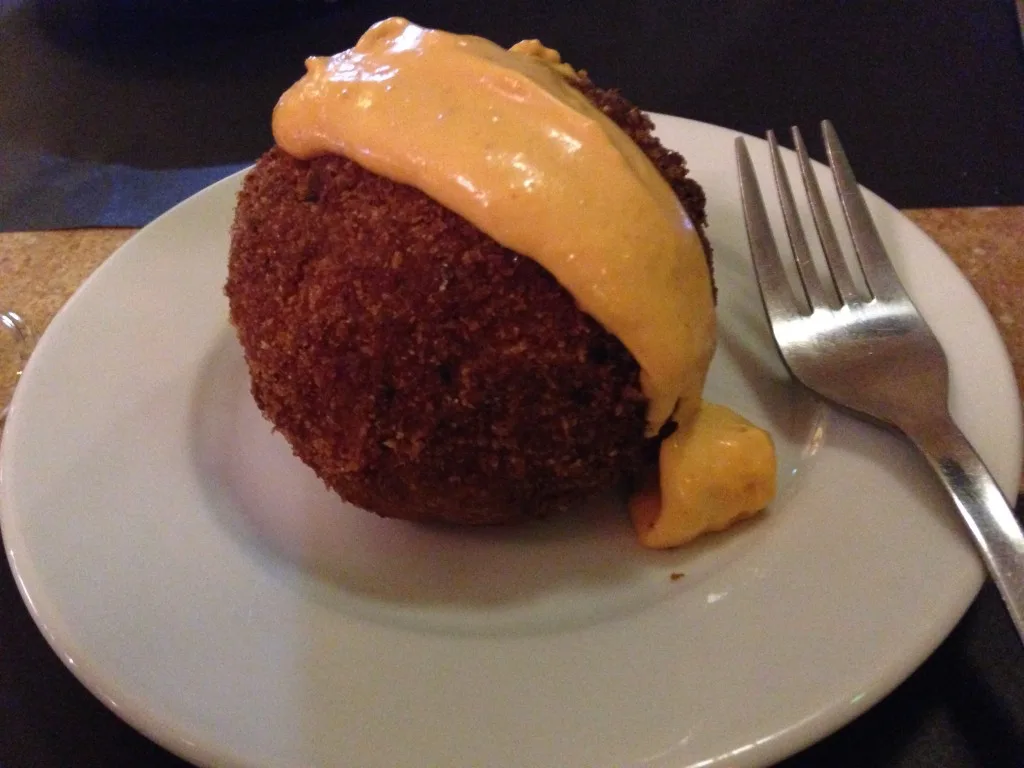
We ask about the prep method and ingredients, and the cook emerges. Yes, there is egg, two in fact. One to bind the meat and potatoes and one to roll La Bomba in. I flash on a weird sort of anarchist parody, with me rolling croquettes in a 1930’s kitchen while animated political discussion rises and falls to the crackle of a radio. La Bomba tapas.
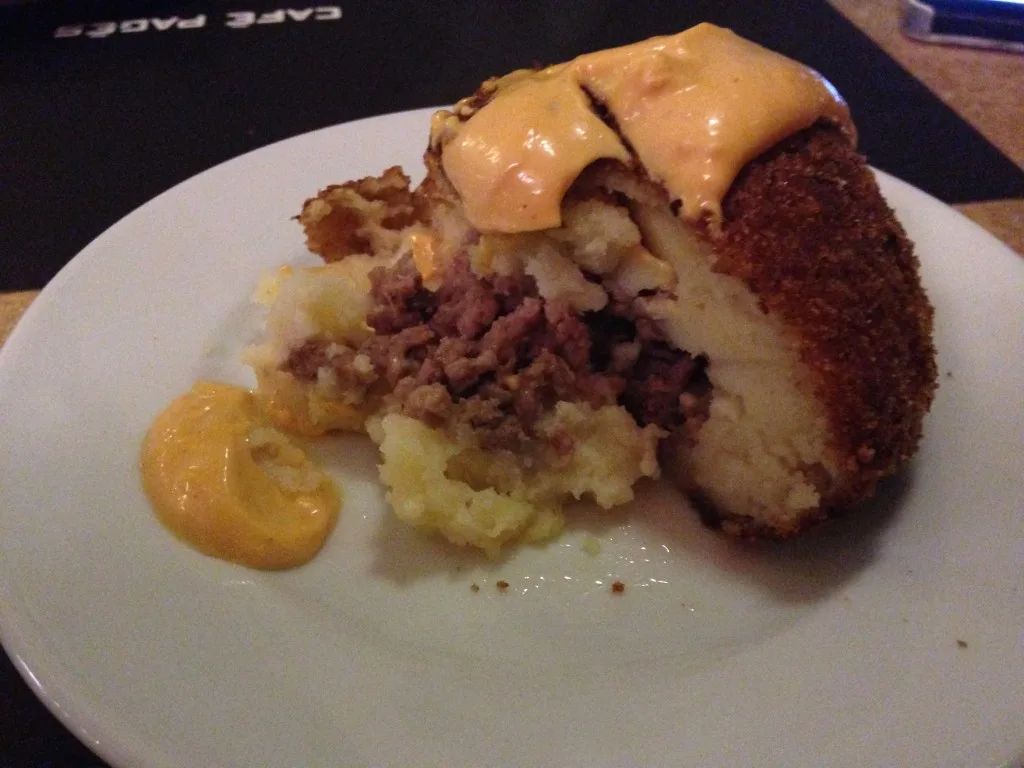
It’s time for us to go. We’re leaving for a few day trips from Barcelona in the morning. The streets of Gràcia are quiet in the mid-evening. I notice an “A” for anarchist symbol in some graffiti as an older couple walks ahead, helping each other along. They are unhurried, in deep conversation. As we pass, he graciously proffers a match, cupping her cigarette with his hands against the wind. We turn down Travessera de Gràcia toward our hotel on the Via Augusta and they are behind us, standing still.
We are grateful to our hosts, Devour Barcelona, for this outstanding introduction to the Barcelona food scene, and fostering our obsession. All opinions are our own.
Practicalities, Tips and Information:
L’Anxoveta, Carrer de Sant Domenèc, 16 (Gràcia). (+34) 934 14 92 23 Tapas, anchovies, octopus, squid and seafood. Daily plates. A variety of local wines. Click here for TripAdvisor reviews.
Cafè Pagès, Torrent de l’Olla, 27 (Gràcia). (+34) 933 68 09 58. Comprehensive cafe menu with tapas, salads, lunch plates and dinners. Full bar. Click here for TripAdvisor reviews.
La Cova Fumada, Carrer Baluart 56 (Barceloneta). (+34) 932 21 40 61, Open at varying times depending upon the day. No sign out front. Point and eat.
Related Tours in Barcelona:
Spanish Civil War Tours in Barcelona visit key sites in the city between 1936-1939, covering anarchism, daily life, George Orwell and other literature, and the effects of bombing. Daily except Wednesdays and Sundays at 10am for between 3.5 and 4 hours. For adults and children 11-15 years of age who should be very interested in history. Click here for TripAdvisor reviews.
Informational video: https://www.youtube.com/watch?t=41&v=Sq3vZkyu3ms
Pinnable Images:

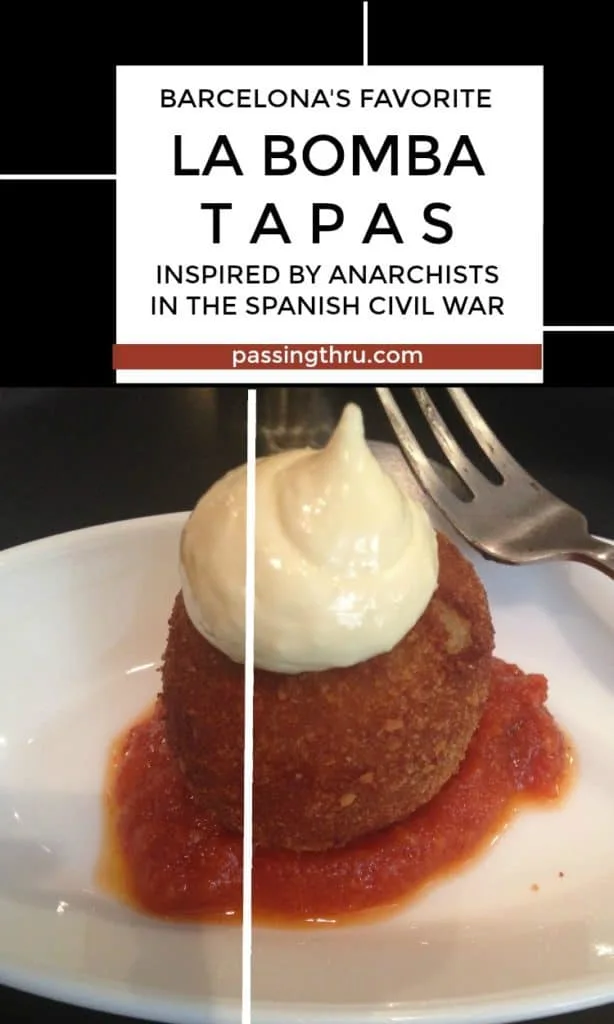

Tips for Trip Success
Book Your Flight
Find an inexpensive flight by using Kayak, a favorite of ours because it regularly returns less expensive flight options from a variety of airlines.
Book Your Hotel or Special Accommodation
We are big fans of Booking.com. We like their review system and photos. If we want to see more reviews and additional booking options, we go to Expedia.
You Need Travel Insurance!
Good travel insurance means having total peace of mind. Travel insurance protects you when your medical insurance often will not and better than what you get from your credit card. It will provide comprehensive coverage should you need medical treatment or return to the United States, compensation for trip interruption, baggage loss, and other situations.Find the Perfect Insurance Plan for Your Trip
PassingThru is a participant in the Amazon Services LLC Associates Program. As an Amazon Associate I earn from qualifying purchases.
To view PassingThru’s privacy policy, click here.





adrian dean molina
Wednesday 11th of December 2019
Hi,
Nice post regarding the history of the bomba. It has been a whole week since I have had a Bomba, yummy.
Suzanne Stavert
Saturday 6th of June 2015
You take me back to a beautiful trip to Barcelona. I wish I would have known about Devour Barcelona! I have read Shadow of the Wind (as well as the other two in the series) I love being able to put myself (at least mentally) in Barcelona. Loved the history in your post.
santafetraveler
Thursday 4th of June 2015
Barcelona is high on my wish list. Tapas and history is a perfect combo for me and the Spanish Civil War has always intrigued me. Would love to go to La Bamba!
Betsy Wuebker
Thursday 4th of June 2015
Hi Billie - It will be the first thing we eat when we return to Barcelona! :)
Donna
Tuesday 2nd of June 2015
I also loved Las Bombas in Barcelona but had no idea of the history behind their creation. Like you, I have to say that period of Spanish history was entirely missing from my schoolbooks. A book I think you would enjoy: Shadow of the Wind, by Carlos Zafon, a novel set in Republican Barcelona. It's one of the best novels I've ever read. I am already wanting to go back to Barcelona. Nice post!
Betsy Wuebker
Tuesday 2nd of June 2015
Hi Donna - I am reading Shadow of the Wind right now!! Another good one: Cathedral of the Sea, set in the Gothic Quarter during medieval times. I also just finished George Orwell's Homage to Catalonia. :)
Rachel
Sunday 31st of May 2015
What a fascinating and romantic history! (And it looks delicious too!) Thank you!
Betsy Wuebker
Sunday 31st of May 2015
Hi Rachel - Thanks, glad you enjoyed it!